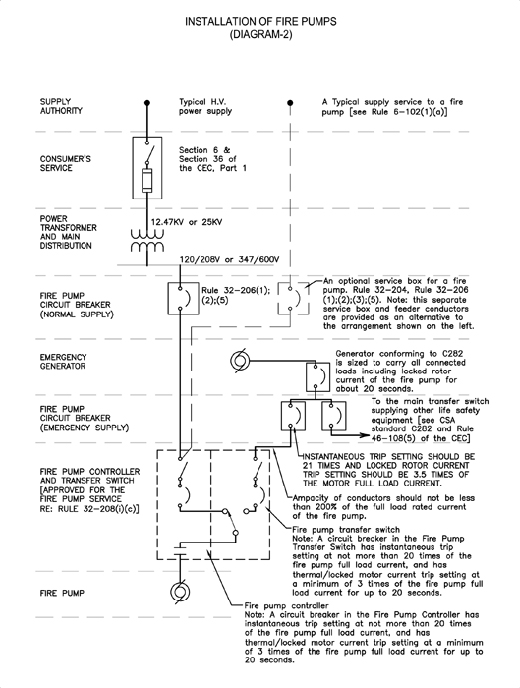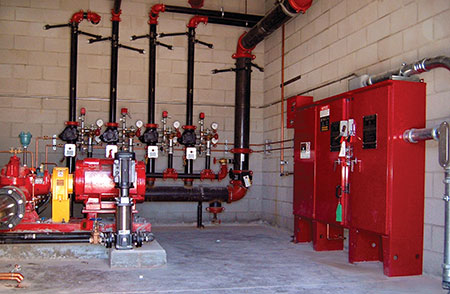
This subject is not new. There have been numerous articles written about the CE Code requirements for fire pump installations and about the selection of the conductors and overcurrent protection for fire pump feeders.
So, what’s the reason to revisit this issue? The answer is:changes to the NFPA 20.
Let’s elaborate. This article is intended to clarify the requirements of Rule 32-206 of the Canadian Electrical Code, Part I – 2009 and to correlate these requirements with the NFPA 20-2010 (the latest published edition of the standard).
Background
1. Rule 32-206(5) of the CE Code requires that the rating or setting of a circuit breaker installed in a normal power supply circuit, upstream of the fire pump controller shall be not less than that of the overcurrent protection that is provided integral with the fire pump controller. Appendix B Note on this Rule clarifies the Code requirement by stating that this circuit breaker should have setting of its overcurrent devices coordinated with the setting of the overcurrent devices of the circuit breaker that is provided integrally with the fire pump controller, and this coordination should be established “in such a manner that the upstream overcurrent device does not disconnect the circuit prior to the operation of the fire pump controller overcurrent protection.” Additional Note in Appendix B on this Rule advises the Code users that NFPA 20 mandates an instantaneous/magnetic trip setting of the circuit breaker in a fire pump controller at not more than 20 times of the full-load current of the fire pump and a thermal trip setting of the value that will allow a fire pump controller to carry locked rotor current for a period between 8 and 20 sec. NFPA 20 also specifies that locked rotor overcurrent protection in the fire pump controller must be “calibrated and set at a minimum of 300 percent of motor full-load current.” Rule 32-206(4) requires that if a circuit breaker is installed in an emergency power supply circuit, upstream of the fire pump transfer switch, then the rating or setting of this circuit breaker must comply with Rule 28-200 (i.e., it must be selected in accordance with Table D16 of the CE Code). This requirement is based on the exception provided in previous editions of NFPA 20 — which was allowing bypass overcurrent protection within the fire pump controller when the power is derived from an emergency generator. This CE Code requirement reflects the fact that a coordination of the O/C protection settings at the circuit breaker installed in the emergency power supply circuit with the O/C settings at the fire pump controller circuit breaker is no longer necessary, as the fire pump controller circuit breaker is bypassed when the power is derived from an emergency generator (see diagram 1).

2. Rule 32-200 of the CE Code mandates that conductors from an emergency power supply to the fire pump must have an ampacity not less than 125% of the full-load current rating of the fire pump motor.It should be noted that this Code requirement is no different than the provisions of Rule 28-106 for branch circuit conductors supplying all other types of individual motors.As this Rule does not specify requirements for selection of the ampacity of fire pump conductors from a normal power supply circuit, the ampacity of these conductors would have to be selected based on the requirements of Rule 28-106 (i.e., they would have to be also not less than 125% of the full-load current rating of the fire pump motor).
It looks like issues addressed by items one and two above might be intertwined by the rules of the current edition of the CE Code.
Let’s discuss these issues.
Discussion
1. Clauses 10.4.3.3. and 10.4.4 of the current (2010) edition of NFPA 20 provide similar requirements for the circuit breaker in a fire pump transfer switch as the requirements that are currently referenced in Appendix B Note on Rule 32-206 of the CEC (i.e.,instantaneous/magnetic trip setting of the circuit breaker in a fire pump controller at not more than 20 times of the full-load current of the fire pump and a thermal trip setting/locked rotor overcurrent protection setting at a minimum of 300 percent of motor full-load current — to allow a fire pump controller to carry locked-rotor current for a period between 8 and 20 sec).However, the exception that was permitted in 1999 edition of NFPA 20 (in the edition that is referenced in Appendix B Note on Rule 32-206 of the CEC) has been removed from the current edition of the NFPA 20.Clause 10.8.2.1.3. of NFPA 20 (that covers requirements for a transfer switch) states the following: “10.8.2.1.3 Circuit Breaker. The transfer switch emergency side shall be provided with a circuit breaker complying with 10.4.3 and 10.4.4.” This means that afire pump transfer switch arranged in a “listed combination Fire Pump Controller and Power Transfer Switch” as described in Clause 10.8.2.1 of NFPA 20 must now be provided with a circuit breaker identical to the circuit breaker in the fire pump controller.This also means that the electrical characteristics of the circuit breaker selected by theelectrical designers upstream of:(a) the fire pump controller – in the normal power supply circuit, and(b) the fire pump transfer switch – in the emergency power supply circuitmust be alsoidentical. This means that the setting requirements described in Rule 32-206(5) of theCEC for the circuit breaker in the normal power supply circuit and coordination ofthese settings with the circuit breaker of the fire pump controllermust be extended tothe circuit breaker installed in an emergency power supply circuit(see diagram 2).

2. Rule 32-200 of the CE Code requires that conductors from an emergency power supply tothe fire pump must have an ampacity not less than 125% of the full-load current rating ofthe fire pump motor. It should be noted that this Code requirement is no different than the provisions of Rule 28-106 for branch circuit conductors supplying all other types of individual motors. Rule 32-200 appears to be conspicuously silent on selection of the ampacity of conductors that connect a fire pump to a normal power supply circuit. Perhaps, this Rule reflects the fact that in the emergency power supply circuit, the O/C protection of the circuit breaker would not have to be coordinated with the circuit breaker in the fire pump controller, as the overcurrent protection in the fire pump controller was allowed to be bypassed in accordance with the 1999 edition of the NFPA (1999 edition of the NFPA 20 is currently referenced in Appendix B Note on Rule 32-206). If this is the case, then 125% of the full-load current rating of the fire pump motorsupplied from an emergency power sourceis the logical ampacity. It should be also noted that ampacity ofbranch-circuit conductors based on 125% of the full-load current rating of any motoris shown in Table D16 of the CE Code, and suchampacityvaluesare correlated with the O/C devices protecting these conductors, as also prescribed by Table D16.Thus, provision of Rule 32-200 for the conductors of the emergency power supply circuit made perfect sense, since the O/C protection of the controller, downstream from the circuit breaker installed in the emergency supply circuit,was permitted to be bypassed.However, in light of thefact thatin accordance with NFPA 2010, the trip settings of the circuit breaker in the emergency power supply circuit willhave to becoordinated with the settings of the circuit breaker in the transfer switch, theconductor ampacitycurrently mandated by Rule 32-200 (125% of the full-load current) may not be nowsufficientto prevent insulation damagefrom being subjected to damage, as these conductors would haveto carry a fault current in excess of 20times of the full-load current.
Conclusion
1. A circuit breaker designed for installation in a normal power supply circuit, upstream of thecircuit breaker in a fire pump controller (see diagram 2) should be selected with aninstantaneous trip setting at 21 times of the full-load current and with thermal/locked rotorovercurrent protection setting at 350% of the motor full-load current.
2. If a transfer switch “approved for fire pump service” in accordance with Rule 32-208(1)(c)of the CE Code meets provisions of the current edition of the NFPA 20 (i.e., is providedwith an integral circuit breaker), then the circuit breaker designed for installation in theemergency power supply circuit, upstream of the circuit breaker in the transfer switch (seediagram 2) shouldalso be selected with an instantaneous trip setting at 21 times of the full-loadcurrent and with thermal/locked rotor overcurrent protection setting at 350% of the motorfull-load current.
3. If a transfer switch “approved for fire pump service” in accordance with Rule 32-208(1)(c)of the CE Code does not meet provisions of the current edition of the NFPA 20 (i.e.,integral overcurrent protection is bypassed in the fire pump controller/fire pump transferswitch arrangements, as shown in diagram 1), then current provision of Rule 32-206(4)of the CE Codecould be met. Note: Proposal to amend Rule 32-206 has been submittedto the Section 32 S/C of the CE Code — toreflect the conclusion2 above.
4. Fire pump feeder conductorsinboth normal and emergency power supply circuitsshould have an ampacity not less than 200% of the full-load current of the fire pump motor or notless than 200% of the sum of the full-load currents of the fire pump, jockey pump and thefire pump auxiliary loads, where two or more motors are provided with the fire pump.Note: Proposal to amend Rule 32-200 hasalso been submitted to the Section 32 S/C of the CE Code — to reflect this conclusion.
5. Fire pump feeder conductors from both the normal and the emergency power supplysources to the fire pump should be protected against fire exposure to provide continuedoperation for not less than 1 h in accordance with sentence 3.2.7.10.(2) of the NBCC2010. (i.e., conductors shall have circuit integrity rating not less than 1 h in accordancewith the ULC S139 “Fire Test for Evaluation of Integrity of Electrical Cables” or be locatedin a service space that is separated from the remainder of the building by a fire separationthat has a fire resistance rating not less than 1 h).
However, it should be noted that the above conclusions only represent observations of the author on this subject, and until these conclusions are incorporated into the CE Code as the result of the submitted proposals, compliance with them is not legally required, as these conclusions simply describe a good engineering practice.













Find Us on Socials